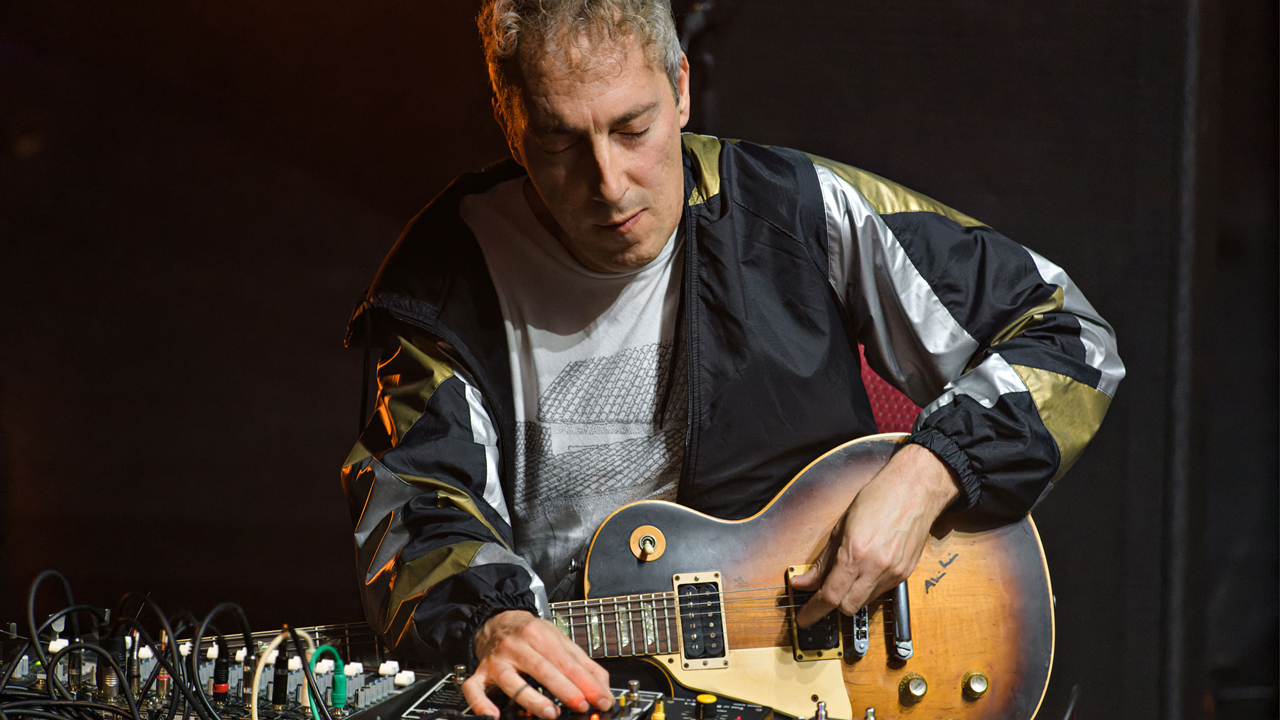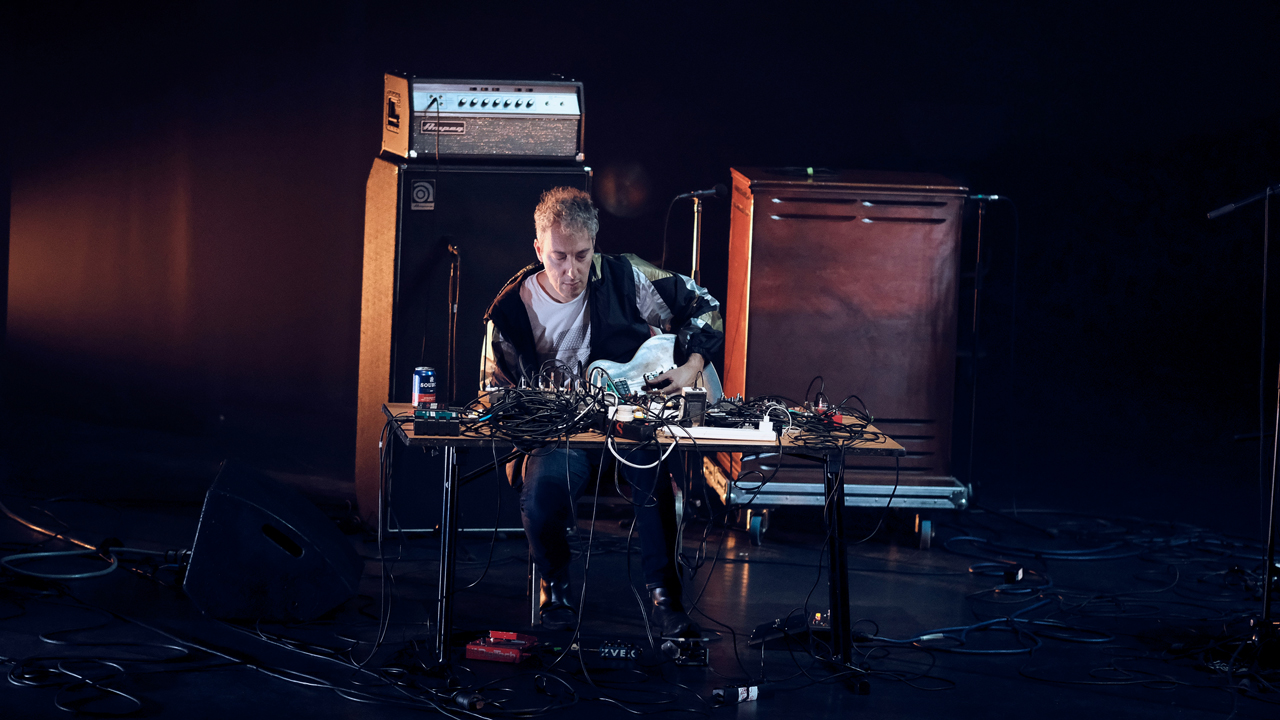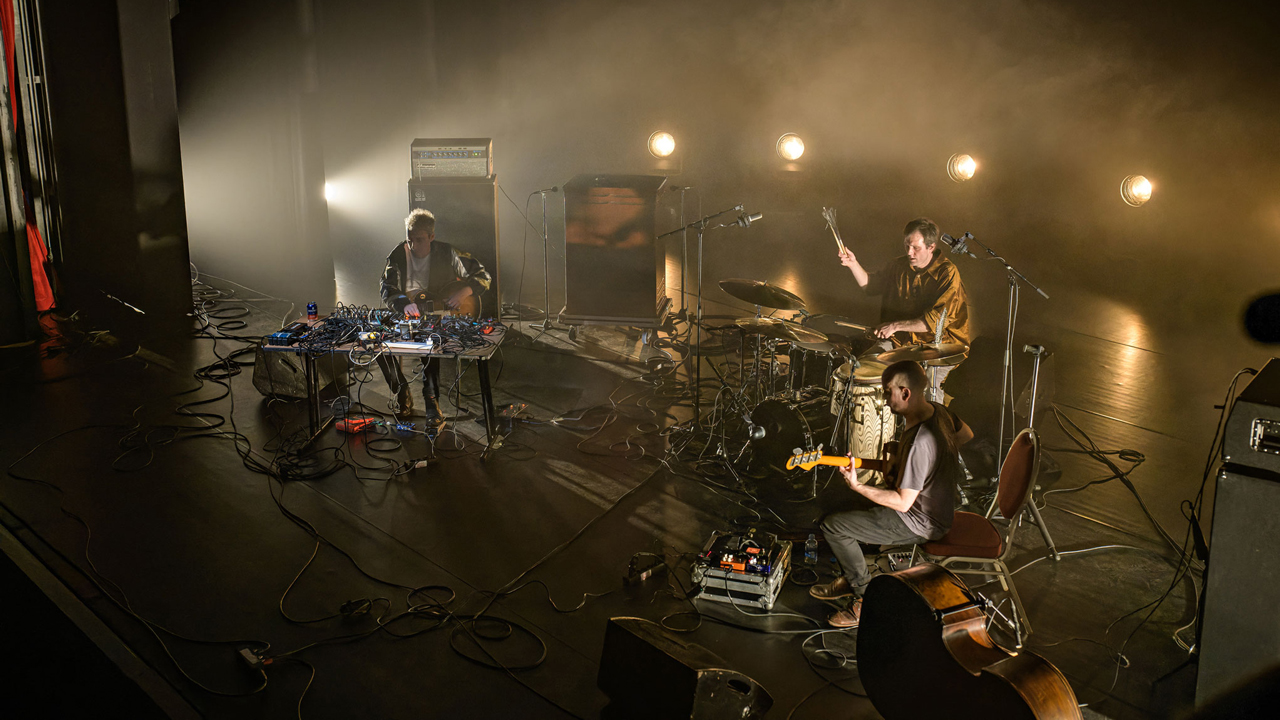
“Guitars & whatnot” is how Oren Ambarchi has been describing his choice of instrumentation in recent years. If that suggests nothing out of the ordinary, the reality is altogether different. Listeners new to Ambarchi’s music would be forgiven for doubting they were hearing any guitars at all.
Ambarchi avoids familiar chord progressions, riffs and song forms in favor of shimmering organ-like tones, glitches, pulses and evolving rhythmic motifs. Using a tabletop bank of pedals and mixer, which he manipulates on the fly, he creates a three-dimensional field of sound that belies its origin in his Gibson Les Paul.
This exploratory approach to the guitar was foregrounded on his earliest solo works. The chopped pitch-shifting effects, stalled dial tones and looping heard on Insulation (1999) and Stacte 3 (2000) sound closer to the software based electronic music of the period than any guitar-based genres.
Over time, by finding the untapped potential in commercial stompboxes, alternate tunings and embracing chance experimentation, Ambarchi has developed a more personal sound that continues to develop across live concerts, solo albums and group releases. Among the most recent standouts are 2022’s Shebang and the first record with a new jazz trio, Ghosted.
It was Jimi Hendrix’s guitar playing that first caught Ambarchi’s ear when growing up in Sydney, though he didn’t pick up the instrument until he was in his twenties, gravitating instead toward the drums.
Forgoing any blues scale exercises, his idiosyncratic style was from the beginning closer to free improvisation heroes like AMM’s Keith Rowe – using extended techniques and effects in unusual ways. Still he has found ways to pay his tribute to his early classic rock heroes, as with his take on Ace Frehley’s Fractured Mirror, on An Audience of One (2012).
The starting point for Ambarchi these days is the thing most guitarists try to avoid: feedback. He tells Guitar World, “It can be quite thrilling, trying to control something that is out of control by its very nature. As the guitar is kind of on the edge of chaos due to the constant feedback, sometimes it’s more than enough to gently touch the open strings to coax various harmonic clouds. A volume pedal is essential.”
Often appearing to do little more than press the strings over the bridge pickup, Ambarchi builds an atmosphere of captivating tones and textures, unlike much else in the guitar world today. Putting familiar pedals to unexpected uses and paying attention to the entire frequency range, he typically runs a split signal through an Ampeg bass amplifier and rotary speaker.

He explains, “I’ve always loved working with things that are ‘wrong’, finding some sort of error or hidden element in a pedal that the manufacturer had no intention of creating. Working exclusively with feedback is an extension of that interest.”
With hands and feet engaged with switches and faders, Ambarchi reveals something of his background seated behind the drum set. It’s a role he still plays on some releases, such as 2012’s monstrous, hypnotic Sagittarian Domain, as well as in his long-running trio with Jim O’Rourke and Keiji Haino – the Japanese artist who directly inspired Ambarchi to finally pick up the guitar in the 1990s.
After sticking to a guitar-only rule for his solo works initially, Ambarchi has brought drums, synthesizers and other instruments into the mix. On the serene, woozy Simian Angel (2019), Brazilian percussionist Cyro Baptista complements Ambarchi’s guitar, while the driving ensemble playing of Hubris (2016) nods to a favourite Italo disco instrumental.
Recent albums have been characterised by their large supporting international casts, Ambarchi recording contributions from a wide circle of fellow musicians individually – including pedal steel legend BJ Cole – and piecing together the final puzzle, of which his distinctive guitar style is but one part.
This gesture of opening out to embrace different colours begins with his own instrument. Ambarchi uses non-standard tunings to achieve less often heard overtones.
“Lately I have been using an open A tuning with my E string dropped all the way down to A. As I'm primarily working with feedback, an open tuning is much more effective for overtones and harmonics.”
Along with a Holy Grail reverb and Superego ‘synth engine’, an Electro-Harmonix 16-Second Digital Delay contributes in large part to the echoing sounds that Ambarchi sculpts, by continual manipulation of the pedal’s sliders.
I was touring as guest guitarist in Sunn O))). Greg Anderson’s guitar fell off an amp during a show and broke, so we went to a Guitar Center in Wisconsin the next morning. I noticed the 16-Second Delay and I remembered being pretty obsessed with it
He recalls, “In 2006 I was touring as guest guitarist in Sunn O))). Greg Anderson’s guitar fell off an amp during a show and broke, so we went to a Guitar Center in Wisconsin the next morning. I noticed the 16-Second Delay and I remembered being pretty obsessed with it, from seeing Bill Frisell live in the ’80s. I bought it on a whim and promptly forgot about it. The first time I used it was for Raga Ooty in 2009. Since then, it’s become an absolutely integral part of my setup.”
At the center of Ambarchi’s tabletop array is a Boss tuner. Even this most unassuming of pedals is put to uncommon use.
“I have various signals in my chain that I send to different channels of a mixer. I often work with sum and difference tones [the basis of ring modulation effects] which create beating patterns, so the tuner comes in handy. I might have one frequency in one channel and a different frequency in another. Working with Alvin Lucier has been a big influence on my solo work.”
Ambarchi’s Tobacco Burst Les Paul bears a special signature on the body – not that of a guitar hero but the acclaimed composer Alvin Lucier, most famous for his study of resonant frequencies, I Am Sitting in a Room (1969).
Ambarchi worked with Lucier in the last decade of his life and has performed and recorded a piece written by the composer for him and Stephen O’Malley, for two guitars and EBow.
Criss Cross explores the acoustic qualities of a single semitone, showing an attention to microscopic detail as much as larger-scale dynamics. Ambarchi has described performing such an apparently simple type of music as “very, very stressful”.

Another crucial component of Ambarchi’s sound is a Leslie cabinet. It was another discovery made during downtime with Sunn O))), this time while recording Monoliths and Dimensions (2009). Plugging his guitar and pedals into an old unit at Studio Litho in Seattle, Ambarchi was hooked.
“There's something so gorgeous about that sound and it's a physical phenomenon – sound moving and reflecting in a space,” he explains. “It's totally three-dimensional. A doppler effect, vibrato, tremolo all in a cabinet built in the early ’40s! Just sitting in front of the cab and listening to its effect is intoxicating to me.”
The reverberating growl and swirl of Ambarchi’s feedback-and-Leslie combination is unleashed against freeform percussion on a recent duo LP, Double Consciousness, with Eric Thielemans.
“People always tell me that there's a new pedal that captures that sound, but it's not possible, as it's a physical phenomenon. I even struggle with having it mic'd through the PA, as it's just not as beautiful and detailed as sitting in front of the cab. Once I played my guitar through it, there was no turning back.”
So addictive and essential is it, one member of the stage team at a recent gig volunteered to spin the faulty Leslie rented for the backline by hand.
“When I played at the End of the Road festival in the UK, the cab was not spinning at all in the ‘slow’ setting, so a lovely chap from the tech crew volunteered to spin it – for the entire duration of my 50-minute set. What a trooper!”
Through his Black Truffle record label, which this year celebrated its 100th release, Ambarchi has reissued little-known but influential experimental records from decades past while supporting many of his favourite composers working today. These include equally boundary-pushing guitarists such as Julia Reidy, whose unique approach to 12-string was the starting point for Shebang.
Ambarchi is still finding no shortage of inspiration in the work of older experimental guitarists too, explaining: “I’ve had this fantasy to find a pedal with a long square wave delay modulation, not unlike Henry Kaiser’s work with the Lexicon PCM42 back in the day.
“I now have two pedals with which I can kind of emulate that vibe, although it’s quite different – one of which is the Red Panda Tensor, which I’m still investigating.”
- Ambarchi's recordings are available from orenambarchi.bandcamp.com and blacktruffle.bandcamp.com.







